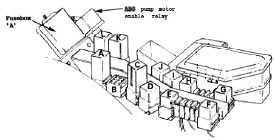| 1. Air Intake System | |
|
Note: I have have changed the wire mesh. The stock 1mm gauge wire in a 3 mm mesh actually cuts flow by 40%. |
|
The re-designed 100 mm inlet is then connected to a Viper Evolution air box, This is the latest generation of the popular Pipercross Viper cold air induction system. The Viper Evolution air filter can support up to 600 hp.
|
The Evolution air filter uses a massive 200mm base, utilising the Pipercross Reverse flow, Common Flow, Technology (RCT©) filter unit. The end result is the least restriction to the air whilst smoothing and increasing the velocity of the cold dense air. The filter incorporates a full 200mm diameter heat shield made from the highest quality
Click To Enlarge |
|
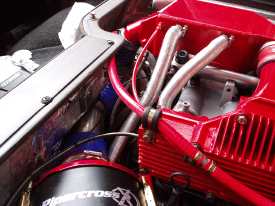 |
| 2. Dump Valves (BOV's) | |
A blow off valve goes under many different names such as dump, bypass, recirc (short for recirculation), diverter, and pop off valves. No one term is correct, the lingo just tends to change in different regions and countries. Basically these valves are all designed to the same job. The only job a blow-off valve is supposed to perform is to relieve excess turbo pressure that results from shutting the throttle rapidly under boost conditions. It is better to release this pressure because it will try to find a way out of the system, and the only way is back out through the turbo. This produces a fluttering noise as the air passes backwards through the turbo, which is unwanted. It is also thought that a blow-off valve can improve turbocharger longevity or, in extreme cases, prevent damage to the turbo due to easing the load on the bearings. The usual arrangement is to have the pressure side of the valve attached to the pipe between the turbo and the throttle, and a vacuum hose on the top of the valve hooked up to the inlet manifold after the throttle body. A spring holds the valve shut. When you are on the throttle, the pressure in the turbo piping and the inlet manifold is equal, meaning that the pressure on each side of the valve is the same and therefore cancels itself out, leaving the spring holding the valve shut. When you lift off the throttle, you have high pressure in the turbo piping, and a vacuum in the inlet manifold. The pressure on the bottom of the valve and the vacuum on the top combine to lift the valve open and release the pressure in the turbo piping, since it can no longer go into the engine. The Lotus 910 engine uses a speed-density fuel management system. Cars that use this arrangement can (usually) be identified by the lack of any Mass Air measuring device. The ECU works out the volume of air entering the engine Mass Air Flow (MAF) by measuring the Mass Air Temperature (MAT) and the Coolant Temperature (CT) at the inlet manifold. It uses these temperatures combined with Volumetric Efficiency (VE) look-up tables (see ECU Tables Page) to estimate the air-flow at a given manifold pressure (MAP). What all this means is that you don't have to use a re-circulating (recirc) valve, a vent-to-atmosphere type would also work well. Perhaps the only possible disadvantages in using a vent-type dump valve is the oil mist that may be deposited in the engine bay if you have a "tired engine" and the extra noise it produces during gear-changes; it sounds like the air-brakes of a large lorry braking behind your head. I used a re-circulating type with the hose fed back down to the bottom of the engine purely for sound suppression. (i) Piston-Type, Bailey Valves I am now fairy sure that these valves need to be individually adjusted to get optimum results in your Esprit, especially if you are running higher than normal boost. For example, the spring tension keeping the valve closed need to be selected correctly otherwise you will get boost leak under full load. As the valve works by the differential pressure that's present across it. However, I have a further worry. At certain rev ranges, the manifold pressure will be at a low depression at the same time the turbo is spinning up, pressurising the induction system in front of the throttle butterfly valves. In this situation, this dump valve will see a higher pressure differential causing it to open and vent the induction system to atmosphere. What this means is you may experience some hesitation or uneven running at part throttle opening, or the car is jerky at part throttle. The Bailey dump valve can be set to open at higher boost pressure but other options are available, see below: |
|
|
|
(ii) Pull-Type, SSQV Valves The HKS Super Sequential Blow-Off Valve (SSQV) The SSQV is constructed of polished billet aluminium, which ensures long-term durability and visual appeal.
Click to enlarge The mounting base utilizes a circular mounting flange that provides exception flow and complete secure mounting via a C-clip snap ring and O-ring gasket.
HKS SSQV Re-Circulation Fitting insert enables the SSQV to reroute discharged compressed air back into the intake stream to create a closed loop system. On the Esprit this can go to the airbox if you have no oil mist or just vented to the atmosphere.
Weld-on steel and aluminium HKS SSQV flanges can be utilized for applications needing custom mounting of SSQV units. Available in 65mm steel, 50mm steel, & 60mm Aluminium. I have seen several US Esprit owners use these flanges to weld onto the plenum. |
|
Fitment to Esprit To enable fitment to the Esprit custom cnc machined adaptor and a special C-clip ring tool were purchased. I wanted to fit The HKS SSQV Bov to the existing Samco T-piece. A special 25 mm aluminium flange fitting was imported from the US and a re-circulating fitting (shown above) was sourced from HKS UK to complete the kit. My fully assembled BOV is shown below. Pictures below show the fully installed HKS SSQV BOV in the engine bay. The manifold vacuum feed is has an inline filter attached. My initial impression have been very positive. The slight hesitation at 3200 rpm in 5th gear at low boost has gone, the car is very much smoother at part throttle.
click to enlarge
|
|
Costs The HKS SSQV bov is not a cheap option. The UK list price for a universal-fitting HKS SSQV Bov is approx £245. You will also need to factor in the price of the adaptor flange. I also had to buy a special tool to lock the O-ring in the flange with the C-clip. Potentially interested buyers should be very careful of eBay vendors selling "HKS-style" bovs, they are cheap nasty Chinese replicas. Be aware of eBay vendors from outside the UK offering discount units, factor in that you will be hit by VAT, import duty and additional handling/administrative charges when they enter the UK. If anyone is interested in one of these setups contact me, I have researched sources for several months now and should be able to help out. |
|
| 5. Engine Side Walls | |
Engine bay side walls were coated in Nomex heat resistant sheeting.
Click To Enlarge |
|
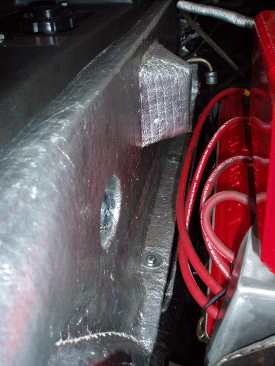 |
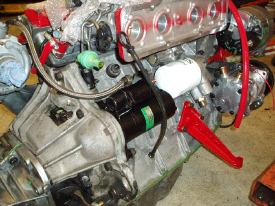 |
| 9. Programmable Wiper | Dave Waters has come up with a very nice mod to allow you to change the
Click to enlarge
|
Acknowledgements
I would like to thank my very good friend Justin McAulay for all his helo with the project.

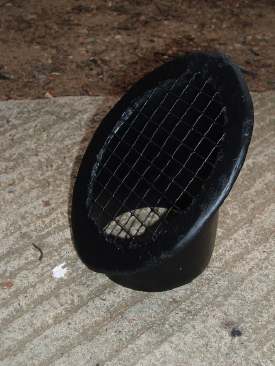
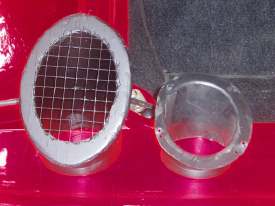
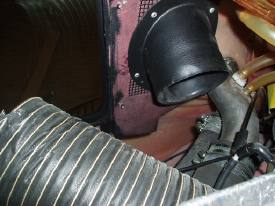 Air enters the car via a drivers side air intake duct. This consists of a 80mm wire mesh covered plastic intake nozzle which connects on to a flexible 80mm hose over the wheel arch and then to the panel air filter. The common "ram air" mod redirects the air directly to the flat panel air filter. The volumetric air flow (V) is given my the equation V = a.v, were a is the cross sectional area and v is the air velocity. Since the area for a circular pipe is given by (pi) x radius ^2. Increasing the inlet air intake from 80 mm to 100 mm will almost double the volumetric air flow for the same air velocity.
Air enters the car via a drivers side air intake duct. This consists of a 80mm wire mesh covered plastic intake nozzle which connects on to a flexible 80mm hose over the wheel arch and then to the panel air filter. The common "ram air" mod redirects the air directly to the flat panel air filter. The volumetric air flow (V) is given my the equation V = a.v, were a is the cross sectional area and v is the air velocity. Since the area for a circular pipe is given by (pi) x radius ^2. Increasing the inlet air intake from 80 mm to 100 mm will almost double the volumetric air flow for the same air velocity. 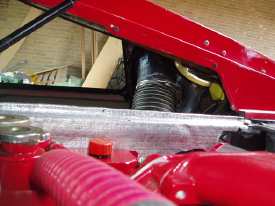
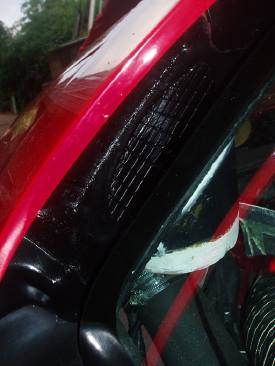
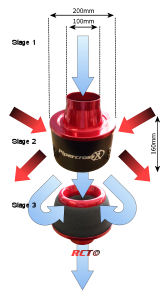
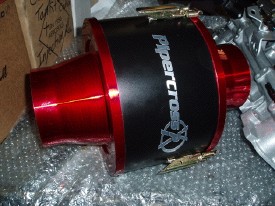
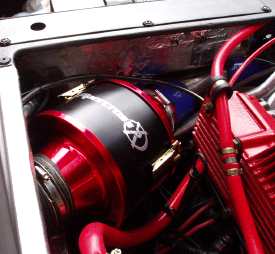
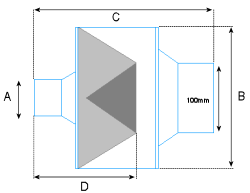
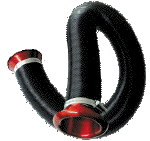 On the intake side of the air filter the cold air feed is a 100mm bore tube. It is fed directly from the air intake on the right hand side. This ensures maximum ram air effect, minimum air flow restriction whilst supplying the RCT© filter with cold oxygen enriched air.
On the intake side of the air filter the cold air feed is a 100mm bore tube. It is fed directly from the air intake on the right hand side. This ensures maximum ram air effect, minimum air flow restriction whilst supplying the RCT© filter with cold oxygen enriched air.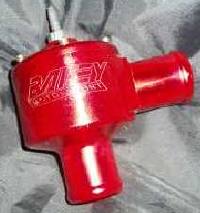
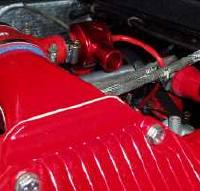
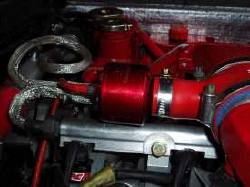
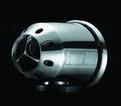 is a dual stage pull-type relief valve. Unlike the Bailey-type valves that are push type valves, the SSQV will not leak under any level of boost because the boost pressure in chamber "C" keeps the valve closed against its seat (
is a dual stage pull-type relief valve. Unlike the Bailey-type valves that are push type valves, the SSQV will not leak under any level of boost because the boost pressure in chamber "C" keeps the valve closed against its seat (


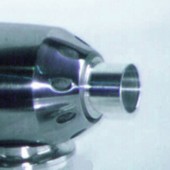
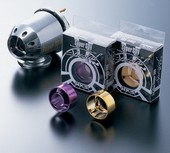 The HKS SSQV can also be fitted with a silver triple-fin discharge designed to produce a powerful and unique aggressive "Jap-style" blow-off sound. Triple-fin inserts are available in gold (standard high frequency sound) and in purple metallic (emits a lower frequency sound than both the standard and gold SSBV inserts) for an alternate sound and appearance.
The HKS SSQV can also be fitted with a silver triple-fin discharge designed to produce a powerful and unique aggressive "Jap-style" blow-off sound. Triple-fin inserts are available in gold (standard high frequency sound) and in purple metallic (emits a lower frequency sound than both the standard and gold SSBV inserts) for an alternate sound and appearance. 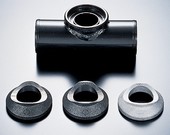
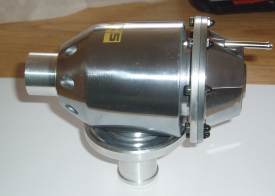
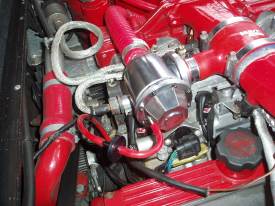
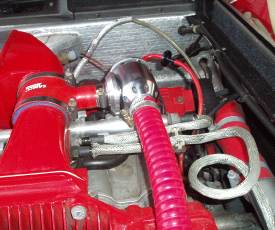
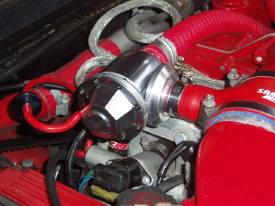
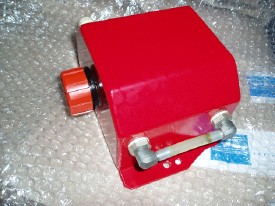

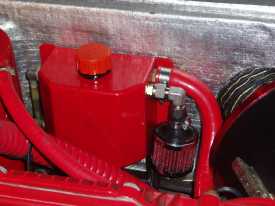
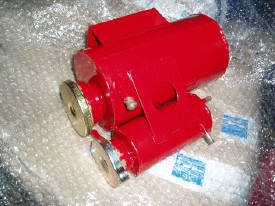
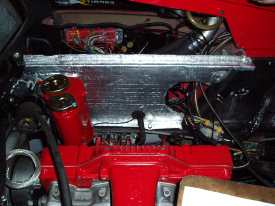
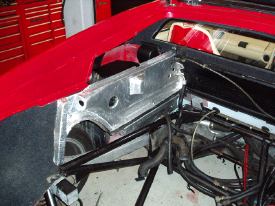
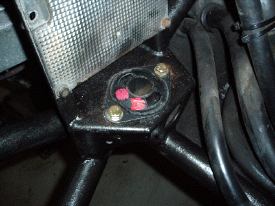
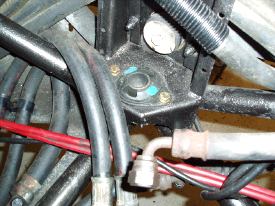
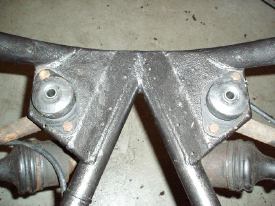
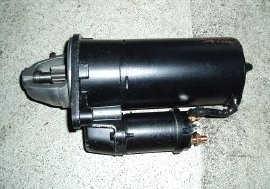
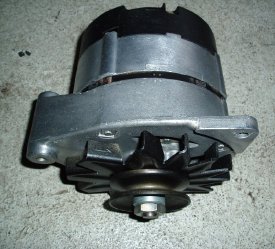
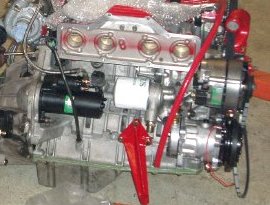

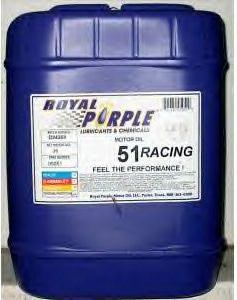
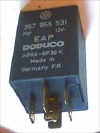 delay in the wiper motor when you are on the intermittent setting. It has been fully documented on
delay in the wiper motor when you are on the intermittent setting. It has been fully documented on 